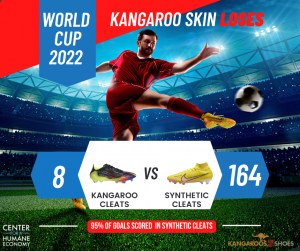Lionel Messi, Kylian Mbappe, and other global soccer stars chose not to wear Nike or Adidas football boots made from kangaroos killed in the wild in Australia
With the World Cup in the history books, we know that kangaroo-based shoes represent not only a moral failure, but a marketing and performance flop.”
— Wayne Pacelle, president, Center for a Humane Economy
WASHINGTON, D.C., UNITED STATES, December 19, 2022 /EINPresswire.com/ -- Lionel Messi, Kylian Mbappe, and other soccer stars performed on the global stage in the 2022 World Cup without lacing up soccer cleats made from the skins of
kangaroos killed in the wild in Australia.According to an analysis of all matches, conducted by the Center for a Humane Economy, World Cup players scored 172 goals throughout the competition — and only eight came from players weaking kangaroo-skin cleats.
Nike, Adidas, Mizuno, and other athletic wear companies offer dozens of models made from the skins of the marsupials, who are one of the iconic mammals of Australia, while also offering a larger line of shoes that do not require killing native wildlife in mass numbers. In all, the Center determined that the vast majority — more than 95 percent — of all World Cup goals made this year are from players wearing shoes from man-made fabrics, and just 5 percent from kangaroo-based shoes.
“When it comes to performance, kangaroo leather cleats are clearly outmatched,” said Natasha Dolezal, senior legal advocate with the Center for a Humane Economy and head of its Kangaroos Are Not Shoes campaign. “Despite the sportwear industry’s decades-long hype about the performance of kangaroo leather soccer cleats, it turns out that more players are choosing modern, human-made materials for better performance. It is long past time for Nike and these other companies to stop sourcing kangaroo skins and driving the mass killing of these animals in their native habitats.”
The kangaroo industry in Australia engages in the largest commercial slaughter of land-based wild animals in the world. Each year, around two million wild kangaroos are gunned down in their native habitat to primarily provide their skins to Nike and Adidas to manufacture underperforming cleats. Kangaroo-based cleats make up an estimated 70 percent of the global demand for kangaroo parts, while pet food accounts for the largest remaining share. Three years ago, the Center for a Humane Economy announced its “Kangaroos Are Not Shoes” campaign to urge the major athletic shoe companies to stop using kangaroo parts in their soccer cleats or football boots.
As horrific as the shooting of millions of adult kangaroos is, the abuse visited each year on hundreds of thousands of baby kangaroos – joeys – is even worse. The defenseless young animals are yanked from pouches and killed by blunt force trauma to the head after their mothers have been shot, often with a violent swing against the side of a car or other solid surface.
“It is a disgrace that Nike and Adidas continue to drive the mass slaughter of kangaroos by making soccer cleat models made from the bodies of kangaroos,” said Wayne Pacelle, president of Animal Wellness Action and the Center for a Humane Economy. “Now with the World Cup in the history books, we know that their kangaroo-based shoes represent not only a moral failure, but a marketing and performance flop.”
A Broken Promise: Nike Just Didn’t Do It
A decade ago, Nike promised to do away with its kangaroo-sourced products, but it has reneged on that explicit pledge. Adidas and others also continue to drive the killing of kangaroos for shoes generally shunned by elite athletes in the sport.
Nike’s Mercurial line boasted the most goals with cleats made of synthetic fiber used by NASA, which is incredibly thin yet strong and flexible. Many consider Mercurials to be the lightest and fastest cleats available. The second-best performing shoe at the 2022 World Cup was the Adidas X range, also a synthetic offering. The obvious loser of the tournament are cleats made with kangaroo skin — Nike’s Tiempo, Adidas’ Copa Sense, and Mizuno’s versions came in at the bottom of the score sheet. (Adidas has said that it will no longer use kangaroo leather in their 2023 Copa cleat.)
This is not the first world-class soccer tournament to show these kinds of numbers. At the European Football Championships in 2021, kangaroo skin shoes tightly swathed the feet of a substantial number of the world’s most elite players. But our analysis, conducted with partner groups in Europe, showed clearly that the shoes didn’t improve performance. In the month-long tournament, players wearing Nikes scored 73 out of 123 total goals. But 72 out of 73 came from models made of Flyknit, another synthetic material. Only one goal was struck with a Nike shoe made from kangaroos.
In 2021, U.S. Representatives Salud Carbajal, D-Calif., and Brian Fitzpatrick, R-Pa., introduced the Kangaroo Protection Act, which would forbid the sale of kangaroo parts in the U.S. California has a similar law, and the Center for a Humane Economy and its partners are working hard to see that it’s properly enforced.


No comments:
Post a Comment